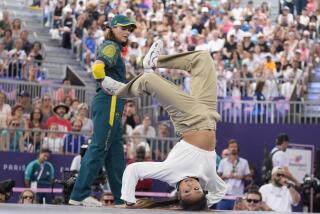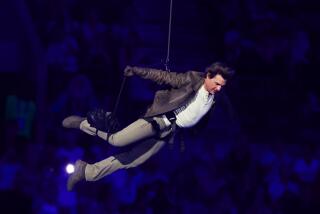In a Pageant of Pomp, Pride and Security, Salt Lake Games Open
SALT LAKE CITY — In a nation at war, the 2002 Olympic Winter Games opened Friday as a celebration of peace, one marked by extraordinarily tight security, a heartfelt display of patriotism and the pageantry of a ceremony that depicted the history and splendor of Utah and the American West.
With F-16 fighter jets on alert in the skies above, 18 members of the 1980 men’s U.S. hockey team lighted the Olympic caldron at the south end of Rice-Eccles Stadium, providing a vivid reminder of perhaps the greatest moment in the country’s Winter Olympic history.
“On behalf of a proud, determined and grateful nation, I declare open the Games of Salt Lake City, celebrating the Winter Olympic Games,” President Bush said, departing from the traditional Olympic declaration to include a patriotic preface. Bush delivered the one-sentence address surrounded by the U.S. team.
Outside the stadium, security was predictably tight. But there were few, if any, complaints, and many people said they were surprised by how quickly they moved through the checkpoints.
“It was amazing,” said Debbie Saindon of Roseville, Calif. “I’d say it took 10 minutes in total.”
The security ringing the stadium was merely the most visible feature of the $310 million in funds directed to help secure these Games. An estimated 10,000 police officers and soldiers stood guard at Olympic venues in and around Salt Lake City, a force charged with guarding the first mass gathering of nations since the Sept. 11 terrorist attacks on the World Trade Center and the Pentagon.
“Your nation is overcoming a horrific tragedy,” International Olympic Committee Chairman Jacques Rogge told the audience. “A tragedy that has affected the whole world. We stand united with you in the promotion of our common ideals and hope for world peace.”
The weather, always a concern at the Winter Olympics, forced a postponement of the first competition--ski jump qualifying in Park City earlier Friday. But a low cloud cover that had glowered over the Olympic stadium began to break up just before the opening ceremony, revealing a colorful sunset and a spectacular view of the Wasatch Range immediately to the east. The five Olympic rings could be seen burning white on the side of the range. A short time later, a light snow began to fall, as if on cue. The temperature was 19 degrees.
Just as noticeable as the security was the overwhelming, and largely unscripted, outpouring of U.S. patriotism. Bush was greeted by a deafening roar as he arrived in the stadium. U.S. athletes waved small American flags as they marched in the parade of nations. The French team waved double-sided flags--the French tricolor on one side, the Stars and Stripes on the other. Plenty of spectators waved back.
“It’s time to come out and show your spirit,” said Alex White, of Daytona Beach, Fla., who attended the ceremony with a friend. Both showed that spirit and then some, with red-white-and-blue stovepipe hats, white curly wigs and flag-design bandannas and pins.
The Olympics, of course, are intended to reflect more than mere nationalism, a fact that always seems more poignant in a time of world strife. And so the stadium erupted in cheers--and no audible boos--for Iran, the only participant among the three nations identified by Bush as among an “evil axis” supporting terrorism. Iraq and North Korea--the other nations warned by Bush in his State of the Union address--did not send teams, nor did Afghanistan, which was banned by the IOC for refusing, under its former Taliban regime, to allow women to compete.
A joyous mood permeated the ceremony, especially during the stirring parade of athletes into the stadium. Midway through the procession, the French began doing the wave, and it quickly spread, nation by nation. Even the Mormon Tabernacle Choir joined in.
Once the athletes took their seats beneath the still-unlighted caldron, the colors of their uniforms--the white and red of the German team, the icy blue of Finland, the white and brown coats of the Russians--formed a peaceful patchwork quilt on the south end of the stadium.
“I don’t want to overstate what the Olympics can do,” said Mitt Romney, who took over as president of the Salt Lake Organizing Committee three years ago at the height of the worst corruption scandal in Olympic history, “but at a time like this, maybe more than any time in our history, this gathering at this time has powerful symbolism that is not lost on America or the world.
“Following Sept. 11,” he said, “there were some people who wondered if these Games could be pulled off. Now they seem more important than ever. They can be a source of healing, not only for our nation but for the world.”
An emotional high point of Friday night’s ceremony was the appearance of a tattered flag recovered from the wreckage of the World Trade Center. A hush fell over the stadium as the flag was gingerly carried in by an honor guard of U.S. athletes and New York police and firefighters. It was bathed in light as the Utah Symphony and Mormon Tabernacle Choir performed a majestic rendition of “The Star-Spangled Banner”; then, as the last strains of the anthem sounded, a spotlight flashed on another U.S. flag, which was hoisted up a flagpole to the cheers of the more than 55,000 people in attendance.
An estimated 3 billion more people around the world watched the ceremony on television.
“It was emotional, it was very, very emotional,” said Lt. John Dougherty, a veteran of 38 years with the New York Fire Department, who watched the broadcast with fellow firefighters between alarms at Engine Co. 44 in Manhattan.
At the heart of the ceremony was a colorful pageant of Western history, with musical homage to Native Americans, Western wildlife, Utah’s settlers and the completion of the transcontinental railroad at Promontory Point, Utah. One hundred drummers representing Utah’s five major Indian tribes laid down a beat for ceremonial Native American dances, and the Dixie Chicks played for a pioneer hoedown on skates. Their rendition of “She’ll Be Comin’ ‘Round the Mountain” had the Dutch and U.S. athletes dancing in their seats.
After that raucous interlude, the ceremony turned more solemn with the entrance of the Olympic flag, carried by a color guard featuring two Nobel Peace Prize winners: Bishop Desmond Tutu of South Africa and former Polish labor leader and President Lech Walesa.
The others included former astronaut and U.S. Sen. John Glenn, ski jumper Kazuyoshi Funaki of Japan, runner Cathy Freeman of Australia, French skiing legend Jean-Claude Killy, U.S. film director Steven Spielberg and oceanologist Jean-Michel Cousteau.
Then came the torch lighting, the final peak in an emotional evening that had seen the audience erupt at the sight of U.S. athletes with chants of “USA! USA!” That was the chant first heard around the world in 1980, when the U.S. hockey team beat a heavily favored Soviet squad at the Lake Placid, N.Y., Olympics, the last Winter Games held in the U.S. And it was heard again as the “Miracle on Ice” squad returned to light the torch and stoke the patriotic fervor already burning in Salt Lake City.
More than 2,500 athletes from 77 countries are scheduled to compete in the Games, which run through Feb. 24. There will be 78 events in seven sports; 34 of the 78 are women’s events.
The 211-member U.S. team stands poised to record its best showing at a Winter Olympics, with the possibility of winning at least 20 medals. Its current best is 13 medals, won at the 1998 Winter Games in Nagano, Japan, and at the 1994 Games in Lillehammer, Norway.
The Americans were led into the stadium by flag-bearer Amy Peterson, a short-track speedskater.
The U.S. Olympic Committee has poured millions of dollars in recent years into developing its winter sports programs, and, Romney said, after meeting Friday afternoon with the U.S. team, “they are pumped.”
He then went on to distill the magic and heartbreak that always seem to mark the athletic competition at the Games: “They’ve been preparing for this moment for four years and in some cases it will last less than a minute.”
These Games arrive after a recent history marked by controversy and fear--in particular, the Salt Lake City bid scandal and then, in the aftermath of Sept. 11, security worries.
At stake may be nothing less than the future direction of the Olympic movement, particularly in this country. These will be the last Olympics in the United States for at least 10 years.
Rogge acknowledged that the stakes are high. In an interview last week, he said the Games “are important for Olympism in this country.”
USOC officials have made it plain that the success of future U.S. bids for the Games may hinge on the success of the Salt Lake City Olympics. Four U.S. cities are vying for the 2012 Summer Games: New York, Washington, San Francisco and Houston.
Salt Lake City has been preparing for this moment since June 1995, when it won the right to the these Games.
At the time, the Olympic movement worldwide was still reveling in the success in the United States of the 1984 Los Angeles Olympics, and anticipation was building toward the 1996 Summer Games in Atlanta.
The 1996 Games are now remembered, however, for a carnival-like atmosphere that sparked IOC complaints of commercial excess, for transportation and technology woes and, perhaps most of all, for a bomb that exploded in a downtown Atlanta park, killing one person and injuring more than 100.
The 1998 Nagano Winter Games were plagued by bad weather. Also, because of the time zone differences, much of the U.S. knew what had happened at the Games before the action was shown on prime-time television.
In Sydney, Australia, 17 months ago, the time-zone problem again was evident. Plus, NBC, which holds the exclusive rights to broadcast the Games in the United States from 2000 through 2008, chose to show virtually the entire Summer Olympics on tape delay.
Meantime, in late 1998, in the months between the Nagano and Sydney Olympics, the bid scandal erupted here in Salt Lake City.
The scandal centered on revelations that bidders had wooed IOC members or their relatives with more than $1 million in cash, gifts and other inducements.
Ten IOC members were expelled or resigned. The IOC in late 1999 passed a 50-point reform plan that included a ban on visits to cities bidding for the Games.
The two leaders of the bid, Tom Welch and Dave Johnson, were indicted in July 2000 on federal fraud and other charges. A U.S. district judge dismissed the case in November, but only days ago prosecutors filed an appeal--thereby assuring that the scandal would stay in the spotlight for the duration of these Games and beyond.
As for security, a thorough review was undertaken after Sept. 11. The $310 million devoted to security is far and away a record for a U.S. Games.
By comparison, the federal government’s share of security funding for the Winter Games at Lake Placid, N.Y., in 1980 was $23 million, according to the General Accounting Office. Salt Lake City’s share is more than 10 times that.
Bill and Pam Skinner, attending the opening ceremony from nearby Park City, said they weren’t worried.
“There are a lot of people that live here that are staying away because they are afraid,” Bill Skinner said. “We don’t want to do that. That means [the terrorists] win.”
*
Times staff writers Julie Cart and Tom Gorman in Salt Lake City, Mitchell Landsberg in Los Angeles and John J. Goldman in New York contributed to this report.
More to Read
Go beyond the scoreboard
Get the latest on L.A.'s teams in the daily Sports Report newsletter.
You may occasionally receive promotional content from the Los Angeles Times.







